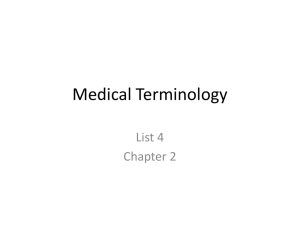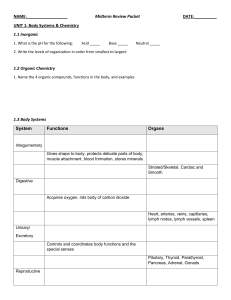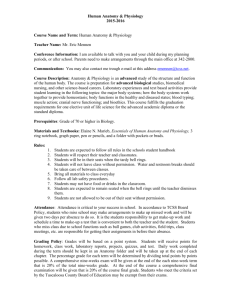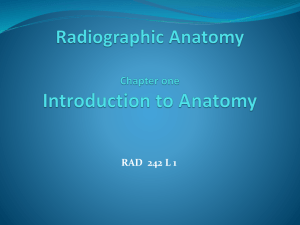Campus Location: Georgetown, Dover, Stanton, Wilmington
advertisement
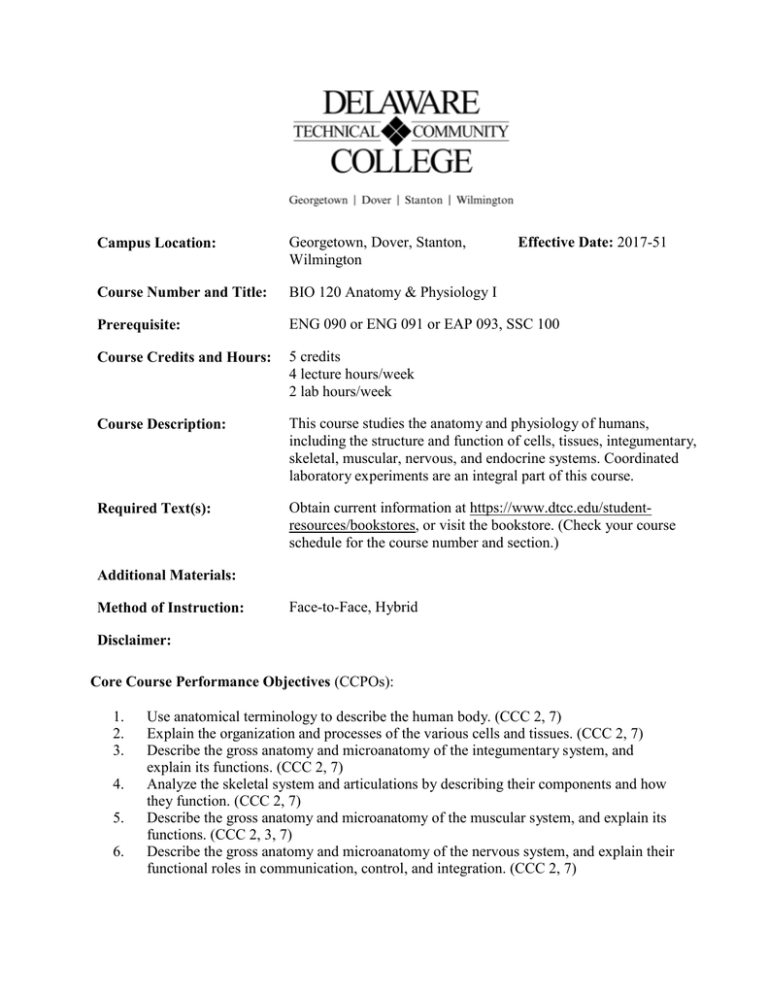
Campus Location: Georgetown, Dover, Stanton, Wilmington Effective Date: 2017-51 Course Number and Title: BIO 120 Anatomy & Physiology I Prerequisite: ENG 090 or ENG 091 or EAP 093, SSC 100 Course Credits and Hours: 5 credits 4 lecture hours/week 2 lab hours/week Course Description: This course studies the anatomy and physiology of humans, including the structure and function of cells, tissues, integumentary, skeletal, muscular, nervous, and endocrine systems. Coordinated laboratory experiments are an integral part of this course. Required Text(s): Obtain current information at https://www.dtcc.edu/studentresources/bookstores, or visit the bookstore. (Check your course schedule for the course number and section.) Additional Materials: Method of Instruction: Face-to-Face, Hybrid Disclaimer: Core Course Performance Objectives (CCPOs): 1. 2. 3. 4. 5. 6. Use anatomical terminology to describe the human body. (CCC 2, 7) Explain the organization and processes of the various cells and tissues. (CCC 2, 7) Describe the gross anatomy and microanatomy of the integumentary system, and explain its functions. (CCC 2, 7) Analyze the skeletal system and articulations by describing their components and how they function. (CCC 2, 7) Describe the gross anatomy and microanatomy of the muscular system, and explain its functions. (CCC 2, 3, 7) Describe the gross anatomy and microanatomy of the nervous system, and explain their functional roles in communication, control, and integration. (CCC 2, 7) 7. 8. 9. Explain the gross anatomy and microanatomy of the body’s special senses and their functions. (CCC 2, 7) Describe the gross anatomy and microanatomy of the endocrine organs and their functions. (CCC 2, 7) Apply various lab activities related to anatomy and physiology. (CCC 2, 3, 4, 5, 7) See Core Curriculum Competencies and Program Graduate Competencies at the end of the syllabus. CCPOs are linked to every competency they develop. Measurable Performance Objectives (MPOs): Upon completion of this course, the student will: 1. Use anatomical terminology to describe the human body. 1.1 1.2 1.3 1.4 1.5 1.6 1.7 1.8 1.9 2. Explain the organization and processes of the various cells and tissues. 2.1 2.2 2.3 2.4 2.5 3. Define anatomy and physiology. Describe the anatomical position. Identify the correct anatomical term used to describe a region of the body. Use directional terms and sectional planes to describe relationships among body structures. Distinguish the levels of structural organization. Identify the eleven principal body systems, their organs, and their function. Locate the major body cavities and the organs contained in each. Describe and compare the internal and external environments of the cell. Explain the concept of homeostasis, including negative and positive feedback systems. Distinguish cell types, and describe the function of generalized organelles found in most body cells. Describe the various biological molecules and biochemical processes in a cell. Describe the structure and function of the plasma membrane and its mechanisms of transport. Describe the phases of the cell cycle in a somatic cell. Describe the characteristics and functions of the four main tissue types. Describe the gross anatomy and microanatomy of the integumentary system, and explain its functions. 3.1 3.2 3.3 3.4 Describe the structure and function of the epidermis and dermis (skin). Describe the factors that influence skin color. List the epidermal derivatives, and describe their structure and general functions. Explain how the integumentary system regulates body temperature. 4. Analyze the skeletal system and articulations by describing their components and how they function. 4.1 4.2 4.3 4.4 4.5 4.6 4.7 4.8 4.9 4.10 5. Describe the gross anatomy and microanatomy of the muscular system, and explain its functions. 5.1 5.2 5.3 5.4 5.5 5.6 5.7 5.8 5.9 5.10 5.11 5.12 6. Identify the bones of the axial and appendicular skeletons. Identify the types of bones based on shape and composition, and relate the shapes of bones to their functions. Identify bone markings, and describe their functions. List the curves of the vertebral column. Compare the major structural differences between the male and female skeleton. Describe the gross anatomy of a long bone. Compare endochondral and intramembranous ossification. State the significance of the epiphyseal line. Describe bone remodeling. Compare the structure, degree of movement, and location of fibrous, cartilaginous, and synovial joints. Describe the organization of the skeletal muscle at the tissue level. Identify the structural components of a muscle fiber. Identify the structural components of a sarcomere, and differentiate between thick and thin filaments. Summarize the events that occur at the neuromuscular junction. Explain the sliding filament mechanism of contraction. Discuss factors that affect muscle tension. Explain skeletal muscle metabolism. Differentiate between fast and slow twitch muscle fibers. Distinguish between isotonic and isometric contractions. Define agonist, antagonist, and synergist, and provide an example of each for a specific movement. Define origin, insertion, and belly. Identify the principal skeletal muscles of the human body and how these muscles are named. Describe the gross anatomy and microanatomy of the nervous system, and explain their functional roles in communication, control, and integration. 6.1 6.2 6.3 6.4 6.5 6.6 Describe the organization of the nervous systems from both anatomical and functional divisions. Identify the structure and function of neurons and neuroglia. Explain neurophysiology including mechanism of resting membrane potential, production of action potentials, and impulse transmission. Explain signal transmission across the synapse and the role of neurotransmitters. Describe neuronal circuits. Describe the gross and cross-sectional structure of the spinal cord and its major functions. 6.7 6.8 6.9 6.10 6.11 6.12 6.13 7. Explain the gross anatomy and microanatomy of the body’s special senses and their functions. 7.1 7.2 7.3 7.4 7.5 7.6 7.7 7.8 8. Describe accessory structures of the eye. Identify and describe the structural divisions and components of the eye. Describe the process of image formation. List the structures forming the visual pathway to the brain. Describe the anatomical divisions of the ear and their components. Describe the sense of equilibrium and the structures involved. List the sequence of steps involved in the physiology of hearing. Describe olfactory and gustatory processes. Describe the gross anatomy and microanatomy of the endocrine organs and their functions. 8.1 8.2 8.3 8.4 8.5 8.6 9. Describe the structural components and organization of spinal and cranial nerves. Explain the process of a spinal and cranial reflex. Identify the major parts of the brain, and describe the functions of each. Explain how the brain is protected, and discuss the formation, circulation, and function of the cerebrospinal fluid. Describe the classifications and roles of the different sensory receptors. Describe the sensory and motor neural pathways. Describe the divisions and functions of the autonomic nervous system. Compare and contrast the nervous system and endocrine system. Define a hormone, and distinguish between the different types. Identify chemical classes of hormones, and give examples of each. Compare the two mechanisms of target tissue stimulation. Explain the role of the hypothalamus and anterior pituitary in regulation of hormone release. Identify the endocrine glands, their hormone(s), and their action(s). Apply various lab activities related to anatomy and physiology. 9.1 9.2 Identify anatomy of the integumentary, skeletal, muscular, nervous, and endocrine systems on models, specimens, diagrams, and/or computer programs and dissection in a laboratory situation. Perform various physiological laboratory activities related to the cell, as well as the integumentary, skeletal, muscular, and nervous systems. Evaluation Criteria/Policies: Students must demonstrate proficiency on all CCPOs at a minimal 75 percent level to successfully complete the course. The grade will be determined using the DTCC grading system: 92 83 75 0 – – – – 100 91 82 74 = = = = A B C F Students should refer to the Student Handbook (https://www.dtcc.edu/academics/studenthandbook) for information on the Academic Standing Policy, the Academic Integrity Policy, Student Rights and Responsibilities, and other policies relevant to their academic progress. Core Curriculum Competencies (CCCs are the competencies every graduate will develop): 1. 2. 3. 4. 5. Communicate clearly and effectively both orally and in writing. Demonstrate effective problem solving and reasoning skills. Work effectively in groups of people from diverse backgrounds. Demonstrate ethical and professional understanding and conduct. Apply appropriate information literacy skills to locate, evaluate, and use information effectively. 6. Use computer technology appropriate to the field. 7. Use scientific and mathematical reasoning appropriate to the technology.

